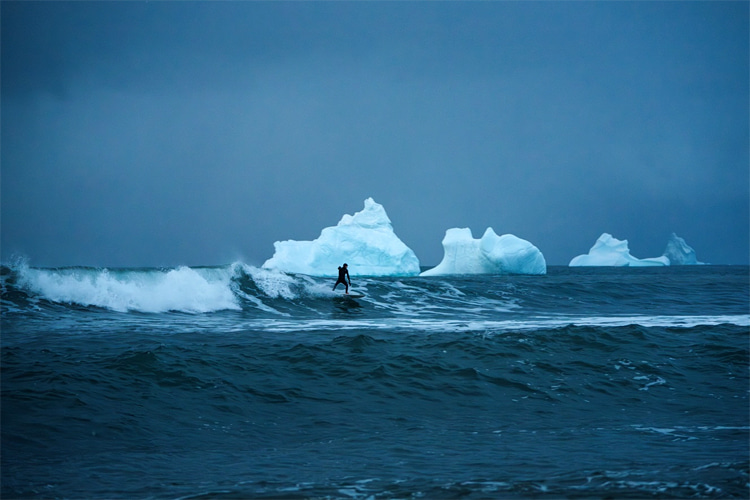
It is the world’s largest island (that isn’t a continent). Welcome to Greenland, a territory where nearly 80 percent of its surface is blanketed by an enormous ice sheet.
Greenland spans over 2.16 million square kilometers, making it the largest island on Earth. Impressive.
Nevertheless, for obvious reasons, it is home to only around 56,500 people, one of the least densely populated places on the planet.
Also, the northernmost point of Greenland is just 1,030 miles (1,660 kilometers) away from the North Pole.
Here, everything is extreme.
If the entire Greenland ice sheet were to melt, global sea levels would potentially rise by around 23 feet (roughly 7 meters).
Most residents live in small coastal towns, with Nuuk, the capital, home to roughly one-third of the total population.
The island’s name, Greenland (in Greenlandic, Kalaallit nunaat), is credited to Erik the Red, a Norse explorer who reportedly chose the name to attract settlers.
Although much of the land is icy, the southern coastal regions can be surprisingly green in the summer.
Greenland is an autonomous territory within the Kingdom of Denmark. It manages most of its domestic affairs independently, yet the European nation retains control over its foreign policy and defense.
Sadly, the region is warming about four times faster than the global average.
The acceleration in melting not only contributes to sea level rise but also opens up access to previously locked‐up resources like rare earth minerals and potential oil and gas reserves – adding both opportunities and geopolitical complexities.
We know how it plays, right?

Surfing Melting Glaciers
Greenland’s rugged terrain and scattered settlements mean there are no roads linking its towns.
Travel between communities is primarily by boat, airplane, or, in winter, by snowmobile or dogsled.
And while that is not necessarily a problem for surf travelers, it does shift the paradigm of surf exploration.
One of its most famous natural features is the Jakobshavn (or Ilulissat) Glacier – one of the fastest-moving glaciers in the world.
Its rapid flow and massive calving events contribute significantly to Greenland’s ice loss and global sea level changes.
In 2024, Portuguese surfer Eurico Romaguera and Spanish photographer Jorge Abian waited patiently for massive chunks of glaciers to break and create rideable waves near Ilulissat.
And after two days, they got away with the perfect ride and shot.
Interestingly, the spot is not far from Qeqertarsuaq (Godhavn in Danish), one of the few known places in the territory where surfers have been spotted riding waves.
But before paddling out at Greenland’s surfing capital, let’s learn a bit more about swell and wind patterns in the “Land of the People” (Inuit Nunaat).

Arctic Swell and Wind Patterns
Greenland is a vast region surrounded by cold waters.
It is surrounded by the Arctic Ocean (N), North Atlantic’s Greenland Sea (NE), Norwegian Sea (E) and Labrador Sea (S), and by the deep Baffin Bay (W).
Greenland’s coastal and inland wind‐and‐swell environment is shaped by a combination of large‐scale North Atlantic storm activity, the huge expanse of the Greenland Ice Sheet, and complex local topography.
Winter Action
During the winter months, storm systems in the North Atlantic are more active.
They generate long‐period swells that travel great distances, leading to rough coastal seas along Greenland.
At the same time, the interior of the ice sheet radiatively cools, producing strong katabatic winds – downslope winds that can reach high speeds.
On the east coast, these winds often take the form of piteraq winds, which are notorious for their extreme gusts (often between 50 and 80 m/s and sometimes higher) that can produce significant surface roughness and help generate even larger locally driven waves.
These North Atlantic winter swells are the same that make Iceland’s surfing potential shine during the (extra) cold season.
Summer Unpredictability
In summer, overall wind speeds tend to be lower.
The North Atlantic is typically less stormy, which results in smaller, less energetic swells.
However, the weather in Greenland remains unpredictable.
While large‐scale storm‐generated swells decrease, localized winds – such as sea breezes or residual katabatic flows near the ice margin – can still affect coastal conditions.
These localized winds can sometimes create short‐period waves or modify the existing swell patterns, especially in sheltered fjords and near the ice sheet, where melting alters surface roughness.
Enough for surfing? Barely.

Disko Island: The Surfing Capital of Greenland
If you had to make a bet between Greenland’s west and east coasts when it comes to finding quality surf, you’d probably not pick the west side.
The problem with Greenland’s east coast for surfing is its rugged and near-beachless coastline full of fjords and icebergs.
Also, as soon as you dip into the water near the shore, you’re in deep waters, so there are not many waves rolling in and breaking.
However, there are reports of California surfers scouting the southwest in search of hidden waves. And they apparently found it near Fyllas Vig.
A submerged offshore reef was creating unexpected, rideable surf. The crew named it “White Fang.”
There are also stories of frustrating, failed surf trips to the region.
That is why the west coast is the place to go if you dream of experiencing surfing in this mesmerizing land.
Qeqertarsuaq is the surfing capital of Greenland. It is located on the southern tip of Disko Island in the heart of Baffin Bay and above the Arctic Circle.
It’s like a miniature Arctic version of Hawaii, with stunning rock formations, lush green landscapes, and dramatic waterfalls.
The shoreline here is smoother and more gentle than on the east coast, with a substantially more gradual low-to-deep water gradient.
And its volcanic roots help shape this unique and rare wave.

A Historical Session
In December 2024, surfer Jens Jakob Peterson teamed up with videographer Mads Schmidt Rasmussen and local guide tour operator Disko Adventures to ride and document a proper surf session in the outskirts of Qeqertarsuaq.
They were lucky, and Peterson scored, even though they were in a place with only a few hours of light every day and where the sun never rises before January 13.
Something that would make surfing in Finland, for instance, feel like a tropical paradise – nothing like putting things into perspective, right?
But the waves showed up.
“I think I can only describe this adventure as a dream come true,” revealed Jens Jakob Peterson.
“After looking through Greenland’s coastlines on Google Maps, we found a place with really good opportunities for waves.”
“We knew it would be a huge challenge with everything from ice to being able to get out to the waves but also that we could hit the right weather system.”
“We came up with a plan, and through local help from Danny Mølgaard of Disko Adventures, we could see that there was a possibility.”
“One Sunday afternoon, we saw the weather forecast we needed. A spontaneous decision turned into me sitting on a plane to Greenland the next day, and I was ready for adventure,” concluded the Danish surfer.
With the footage from the historical session, Mads Schmidt Rasmussen plans to release a film about surfing in Greenland.
After all, dreams are made to be lived. Pilluarit!
Words by Luís MP | Founder of SurferToday.com


Leave a Reply